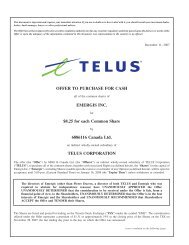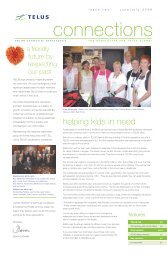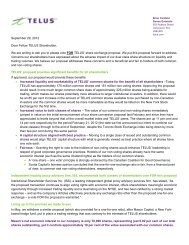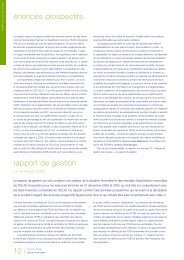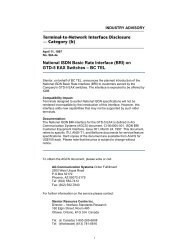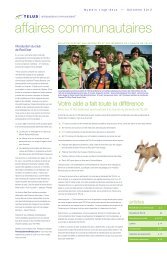Offer to purchase CLEARNET.pdf - About TELUS
Offer to purchase CLEARNET.pdf - About TELUS
Offer to purchase CLEARNET.pdf - About TELUS
Create successful ePaper yourself
Turn your PDF publications into a flip-book with our unique Google optimized e-Paper software.
<strong>TELUS</strong> CORPORATION<br />
(FORMERLY BCT.<strong>TELUS</strong> COMMUNICATIONS INC.)<br />
NOTES TO CONSOLIDATED FINANCIAL STATEMENTS (Continued)<br />
December 31, 1999<br />
1. SUMMARY OF SIGNIFICANT ACCOUNTING POLICIES (Continued)<br />
(e) Depreciation<br />
Assets are depreciated on a straight-line basis over their estimated useful life as determined by a continuing<br />
program of engineering studies. The composite depreciation rate for the year ended December 31, 1999 was<br />
7.8% (7.9% — 1998).<br />
(f) Deferred Charges<br />
Deferred charges include deferred pension costs, more fully described in Note 16, deferred costs of issuing<br />
debt and deferred start-up costs. The deferred start-up costs are amounts relating <strong>to</strong> information services<br />
contracts that will be matched with related revenues. Discounts on long-term debt are amortized <strong>to</strong> interest<br />
expense on a straight-line basis over the remaining lives of the related liabilities. Where interest coupons<br />
and residuals are held as separate investments in sinking funds, discounts are amortized over the period <strong>to</strong><br />
maturity or call date so as <strong>to</strong> produce a constant rate of return on the investments.<br />
(g) Goodwill<br />
Goodwill represents the excess of the cost of acquired businesses over the fair value attributed <strong>to</strong> the net<br />
identifiable assets. Goodwill is being amortized on a straight-line basis over either twelve or fifteen<br />
years. Management estimates the value of goodwill <strong>to</strong> be not less than the unamortized balance at<br />
December 31, 1999.<br />
(h) Income Taxes<br />
The Company and its subsidiaries follow the liability method of accounting for income taxes. Under this<br />
method, current income taxes are recognized for the estimated income taxes payable for the current year.<br />
Future income tax assets and liabilities are recognized for temporary differences between the tax and<br />
accounting bases of assets and liabilities as well as for the benefit of losses available <strong>to</strong> be carried forward <strong>to</strong><br />
future years for tax purposes that are more likely than not <strong>to</strong> be realized.<br />
The balance of future income taxes at December 31, 1999 consists mainly of reserves not available for<br />
current deduction, undepreciated capital cost in excess of net book value of capital assets arising from the<br />
difference between the Company’s depreciation rates and those prescribed for income tax purposes and tax<br />
losses available <strong>to</strong> be carried forward.<br />
(i) Leases<br />
Leases are classified as capital or operating depending upon the terms and conditions of the contracts.<br />
Where the Company is the lessor, the majority of capital leases are through its subsidiary, Telecom Leasing<br />
Canada (TLC) Limited, which acts as a financing intermediary. The long-term leases receivable represent<br />
the present value of future lease payments receivable due beyond one year. Finance income derived from<br />
these financing leases is recorded so as <strong>to</strong> produce a constant rate of return over the terms of the leases.<br />
Where the Company is the lessee, asset values recorded under capital leases are amortized on a<br />
straight-line basis over the term of the lease. Obligations recorded under capital leases are reduced by lease<br />
payments net of imputed interest.<br />
I-11



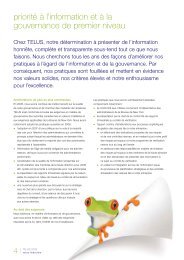
![DISK004:[98CLG6.98CLG3726]BA3726A.;28 - About TELUS](https://img.yumpu.com/16786670/1/190x245/disk00498clg698clg3726ba3726a28-about-telus.jpg?quality=85)
